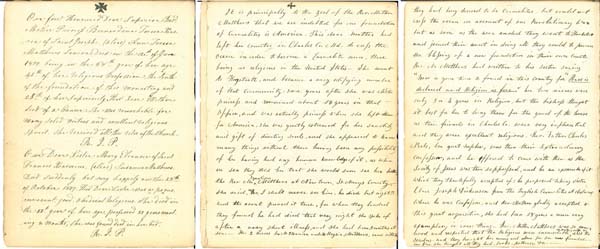Bernardina Matthews was the first in a long line of Carmelite women in the United States. In 1790, the same year John Carroll was ordained the first American bishop, she founded in Port Tobacco, Maryland the first community of women religious in the thirteen original states. This community was significant for three reasons. First, it brought to the newly formed nation and to the first diocese in the U.S. the Teresian Carmelite life and tradition of spirituality; second, while it was unabashedly contemplative, it identified with every aspect of the American Catholic mission; third, it was from its beginning American. The foundress, her two nieces, Mary Eleanora and Mary Aloysia Matthews, and Clare Joseph Dickinson, an English woman, were professed members of the English-speaking monasteries in Hoogstraet and Antwerp, important centers of spirituality for the English recusant community in the seventeenth and eighteenth centuries. The three Matthews, however, were by birth and upbringing Americans of the Anglo-Catholic gentry reaching back to the beginning of the Maryland colony.
 Anne Matthews (1732-90), one of three children, was born in Charles County to Joseph Matthews and Susanna Craycroft. In 1754 she sailed for the Low Countries to join the Carmelites at Hoogstraet where she was professed as Sr. Bernardina Teresa Xavier of St. Joseph a year later. Exceptionally gifted, she was soon appointed mistress of novices and in 1771, at thirty-nine, elected prioress of the community, a position she held until she returned home to Maryland nineteen years later shortly before the armies of the French Revolution overran the Lowlands. The Hoogstraet tradition makes clear Bernardina was deeply loved as prioress, respected as a capable administrator and revered as a wise spiritual guide graced with uncommon contemplative insight. Her experience, natural talents and family heritage combined to provide the leadership that guaranteed a future for the American Carmel and for contemplative prayer in the U.S.
Anne Matthews (1732-90), one of three children, was born in Charles County to Joseph Matthews and Susanna Craycroft. In 1754 she sailed for the Low Countries to join the Carmelites at Hoogstraet where she was professed as Sr. Bernardina Teresa Xavier of St. Joseph a year later. Exceptionally gifted, she was soon appointed mistress of novices and in 1771, at thirty-nine, elected prioress of the community, a position she held until she returned home to Maryland nineteen years later shortly before the armies of the French Revolution overran the Lowlands. The Hoogstraet tradition makes clear Bernardina was deeply loved as prioress, respected as a capable administrator and revered as a wise spiritual guide graced with uncommon contemplative insight. Her experience, natural talents and family heritage combined to provide the leadership that guaranteed a future for the American Carmel and for contemplative prayer in the U.S.
Her greatest contribution is a Teresian spirituality characterized by both openness to God in contemplative prayer and identification with God’s people and the pioneer mission of the American Church. Her strong emphasis on the humanity of Jesus Christ and her devotion to the Sacred Heart place her firmly within the more moderate humanistic tradition and culture typical of Anglo-Catholics reared in Maryland under the guidance of the Jesuits and educated in the Lowlands’ recusant community. Bernardina undoubtedly grew into this devotion as a child and through it established the kind of identification with Jesus that made her desire to pursue Carmelite life. This accent on the humanity of Jesus, on love and interiority, provided fertile soil for the teachings of Teresa for whom Jesus Christ is central. Moreover, in its deepest meanings and development, devotion to the Sacred Heart as it became infused with the Carmelite tradition opened into the experience of contemplative love.
Bernardina was, according to Joseph Chinnici, the inheritor of a muted mysticism and a practical, dignified, restrained piety with definite ecumenical overtones. Her spirituality, grounded in respect for the movement of the Spirit in each person, correlated well with her inherited religious culture and position which prized the values of political liberty, religious toleration, and rights of conscience. In her repugnance for coercion and hardness in leadership, she portrayed an uncommon gentility, humility and mutual respect that spoke both of a spirituality akin to Teresa of Avila and Francis de Sales and also of her upbringing among the Catholic gentry of British America. This latter influence, together with her life among the English Teresians in the Lowlands, probably account for the surprising level of cultural and intellectual life we find in the new community. A very extensive library with volumes in English, French and Dutch was brought across the ocean to America.
Contrary to the separation some twentieth century Carmelite foundations later espoused, actual relationships were central to the nuns’ contemplative prayer mission during the ten years Bernardina led the new community. Archival documents show that the nuns were bonded in prayer, concern and friendship with families and friends, the Catholics of Southern Maryland, the Visitandines in Georgetown, and their persecuted communities they had left behind. They participated totally in the development of the nascent Church through their association with those involved in the American mission: the Jesuits with whom they often shared family ties, Francois Nagot who sought “a union of prayers” on behalf of the French Sulpicians and students in the first U.S. seminary in Baltimore, and particularly Bishop John Carroll and later the pioneer bishops and leaders of the Church. Bernardina Matthews bequeathed to her descendants not only an unswerving faith in the value of contemplative prayer for the larger society but a pattern of communication and partnership essential to Carmel’s meaning and mission. By nurturing contemplation, she transmitted a way of life that encompassed all vocations and situated itself at the heart of the Church and the world.


